With a Little Help From My Friends — The Making of “1000 to 1”
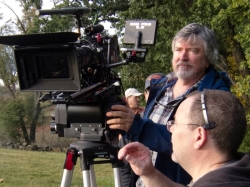 Believe me, being a journeyman DP shooting indie pictures is a hard way to make a living, but it does have its rewards. It can be much more than a job for hire if you are able to enjoy the contagious passion of your filmmaking collaborators. I generally end up getting more involved than just shooting, pulled in by the enthusiasm. This was certainly the case with “1000 to 1: The Cory Weissman Story.” In addition to shooting and serving as Co-Producer, I even had a very small acting role. (Although not as famous as my older brother Jerry “Leave It to Beaver” Mathers, I did a fair amount of acting as a child and still have fun doing the occasional odd bits for my friends.)
Believe me, being a journeyman DP shooting indie pictures is a hard way to make a living, but it does have its rewards. It can be much more than a job for hire if you are able to enjoy the contagious passion of your filmmaking collaborators. I generally end up getting more involved than just shooting, pulled in by the enthusiasm. This was certainly the case with “1000 to 1: The Cory Weissman Story.” In addition to shooting and serving as Co-Producer, I even had a very small acting role. (Although not as famous as my older brother Jerry “Leave It to Beaver” Mathers, I did a fair amount of acting as a child and still have fun doing the occasional odd bits for my friends.)
As with many Indie pictures, the needs of “1000 to 1” were greater than the available resources, but I got by with a little help from my friends. I received assistance with everything from Lensing, Lighting, Filters, (both lighting and camera), and Power Solutions. By way of thanking them and sharing with readers my practical experience using these technologies, (some for the first time on any feature,) I would like to tell you about the tools I employed on this movie.
“1000 to 1” is the inspiring true story of Cory Weissman, a high school basketball star who scored 1,000 points in high school and was expected to be a standout athlete in College. Following a catastrophic stroke at the end of his freshman year, the film chronicles his comeback with the support of his friends, family, and entire college community. Even the opposing team gets in on the act with an amazing show of sportsmanship by helping Cory make the first and only point of his college career.
The movie was graced with the support of Gettysburg College and tremendous production value was afforded by the use of the stately campus where the real events took place, next to the historic battlefields in Gettysburg, PA. Key professionals were brought in from all over the country, and students also filled many support positions. I was hired onto the project by an old college buddy, Bob Burris, who for many years served as a Show Runner for TV hits such as “Growing Pains.” He wrote a great script and Produced along with former Disney Finance Executive, Bruce Gordon, while another television veteran, Michael Levine was brought on to direct.
Even with a modest budget, the project attracted such talent as Beau Bridges (The Descendants), Jean Louisa Kelly (Mr. Holland’s Opus), Michael Lerner (Oscar nominated for Barton Fink), Cassi Thomson (Big Love), and in his first dramatic feature, a great young actor, David Henrie (Wizards of Waverly Place.) I recommended my friends Richard Halsey, ACE, (Academy Award for Rocky) and his wife Colleen Halsey, ACE, to cut the picture, and the famous Latin Jazz Artist, Arturo Sandoval is doing the score.
The ingredients to make a nice little picture were in place, but my humble equipment package was not quite up to the task. It seemed like a worthy project, so I didn’t hesitate to ask for help and the kind assistance of several Manufacturers and Vendors enabled me to have what I needed to get the job done right. I’ll start by telling you about the glass, but let me first explain why, as an owner of a large ensemble of quality lenses, I would need help. For better or worse, we all know RED has been a disruptive force in the field of Digital Cinematography, and I don’t mean this in a critical way. I think the company relishes in it, and much good has come of their influence in the market. The pace of innovation was accelerated throughout the industry and the added price competition resulted in professional level tools being made available to lots more filmmakers. But change is not always easy, and one challenge for me as a RED owner was when they expanded the image area necessary to cover and get the full quality out of the Epic camera. I had invested heavily in lenses as a hedge against the rapid pace of obsolescence in the electronic end of cameras. Glass seemed a safe investment until my old lenses started to vignette on my new Epic. I could keep shooting at the same resolution I had been enjoying with my RED One; after all, the MX sensor was cut from the same cloth, (or chip, as the case may be.) However, I like to get the most out of my gear, so I approached Angenieux, the manufacturer of my much beloved Optimo 17-80mm and encouraged them to find a solution.
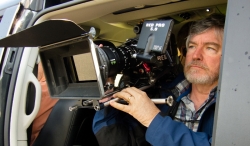 As you might expect it took many, many months, but Angenieux did come up with an answer. They would create a new version of the 17-80mm by reengineering and changing out the rear elements to expand the coverage area. It would also expand the focal length to 19.5-94mm, and the stop would get just slightly slower, (from T2.2 to T2.6,) but the effective angle of view would remain the same as what I’ve grown accustomed to with the 17-80mm. This is a great range for the kind of work I do, wide enough for most masters, and just long enough to get a close-up. I will sometimes put it on the A-camera in the morning and not take it off all day, saving time by using it like a variable prime. A new lens would answer the call, but what about the Optimo I already owned. It turns out they figured out a way to retrofit the 17-80mm and convert it at the factory to the 19.5-94mm, a service they now offer to Optimo owners. Since I had been the one pestering them for so many months, it was agreed that mine would be the first to be converted and I shipped it back to the factory in France. Now I was sure that when the supremely dependable folks at Angenieux told me this was feasible, the quality would be excellent; they never turn out anything less. However, the time table was a bit more sketchy; it is a French company after all, and aside from speeding around Parisian traffic circles, the French don’t like to rush. So with this movie looming, and no firm delivery date set, I decided to explore other options.
As you might expect it took many, many months, but Angenieux did come up with an answer. They would create a new version of the 17-80mm by reengineering and changing out the rear elements to expand the coverage area. It would also expand the focal length to 19.5-94mm, and the stop would get just slightly slower, (from T2.2 to T2.6,) but the effective angle of view would remain the same as what I’ve grown accustomed to with the 17-80mm. This is a great range for the kind of work I do, wide enough for most masters, and just long enough to get a close-up. I will sometimes put it on the A-camera in the morning and not take it off all day, saving time by using it like a variable prime. A new lens would answer the call, but what about the Optimo I already owned. It turns out they figured out a way to retrofit the 17-80mm and convert it at the factory to the 19.5-94mm, a service they now offer to Optimo owners. Since I had been the one pestering them for so many months, it was agreed that mine would be the first to be converted and I shipped it back to the factory in France. Now I was sure that when the supremely dependable folks at Angenieux told me this was feasible, the quality would be excellent; they never turn out anything less. However, the time table was a bit more sketchy; it is a French company after all, and aside from speeding around Parisian traffic circles, the French don’t like to rush. So with this movie looming, and no firm delivery date set, I decided to explore other options.
I remembered from my DCS coverage at NAB that Chuck Lee had demoed a very interesting new concept, a 19-90mm Fujinon zoom called the Cabrio. It had the range I like, covered the expanded image circle of the Epic at 5K, but what was really unique about this lens was that it was designed to be hand-holdable. With this PL mount lens, Fujinon made it more practical and effective to use a large single sensor digital cinema camera in a handheld, shoulder-mount configuration, and the concept made a lot of sense to me. It may look like an ENG lens, yet it had cinema quality glass, in a compact form factor with an integrated zoom servo weighing only about 6 pounds, (2.7 kg.) This meant no more powering a separate motor which tend to slip and often need adjustment, and no more extra cables dangling in the way. In fact, the zoom, iris, and focus all have separate built in motors, which can be accessed from a panhandle control or wirelessly via a new remote being offered in cooperation with Preston Cinema Systems. I like the idea so much I ordered a Cabrio, but again, delivery time was tentative. It wouldn’t be the first movie I’ve shot entirely with primes, but I started to get a little nervous when it was down to about a week and a half before production on “1,000 to 1,” and my two zoom lenses were still at opposite ends of the earth, (Japan and France.) I’m sure my friends at Angenieux and Fujinon started getting pretty tired of my daily calls, but it did pay off. With only two days before the start of production, both lenses arrived on location.
You might call it conspicuous consumption and it’s not a luxury I often get to experience on lower budget movies, having two fine zooms available in the same focal range, but I think I made good use of them both. I could keep the heavier Angenieux built up in Studio configuration on the A-camera, and have the Fujinon ready for handheld or Steadicam on the B-Camera. The Fujinon came in particularly handy shooting the opening title sequence which featured the lead actor David Henrie dribbling a basketball through the historic Gettysburg battlefields. These battlefields make up a national park protected by the U.S. Forest Service, who are very picky about the filming activity they allow. We were able to secure a daylong filming permit with strict limitations, one of which was that the total number of cast and crew would number no more than five, and any basketball bouncing could only happen on the narrow roads that ribbon the monuments. There would be no big crew for dolly tracks or cranes, but I managed to keep pace with David Henrie’s running, and get good camera movement by shooting out the sides and rear of a minivan for which the handheld Fujinon proved ideal. I could quickly adjust the size of the shot without pulling the camera off my shoulder, which was a life saver. “1000 to 1” ended up being the first feature to use either of these two great new lenses, the Angenieux 19.4-95mm Optimo and the Fujinon 19-90mm Cabrio.
This project also allowed me to thoroughly check out the Schneider Optics Platinum IRND filters. I had been an early tester of the prototypes, which quite effectively handled IR pollution at a wide range of ND levels. However, manufacturing problems with the complex dyes needed to achieve good results caused the filters to fade over time. Schneider wasn’t about to release them before they were ready, which resulted in a fairly long backorder. I can now report after using them extensively over many months that this problem is history, and the filters do everything they’re supposed to. With constantly changing weather in the area at that time of year, it was great to have a full set of these on hand, to quickly switch filters to keep the proper exposure level along with the perfect amount of IR filtration.
It was lighting, however, that probably presented the biggest challenge on “1000 to 1,” especially with so much of the action taking place in large basketball arenas. I was really worried when I first saw their shiny new 3,000 seat gym at the Jaeger Center. As basketball stadiums go, it’s a beautiful, state of the art, brightly lit facility that was designed for ESPN to rollup and cover the action. There was going to be no trouble getting an exposure, even for the high speed, and narrow shuttle angle shots I was planning. It looked like what it was supposed to look like, a modern basketball gym, but it would have been extremely difficult to create the kind of high contrast dramatic mood lighting I had in mind in this environment.
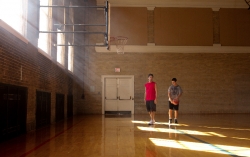 I was relieved to find out on our scout that they had another older gym that was set to be demolished but was still standing. It was dripping with old fashion Hoops charm and looked like it came right out of the movie “Hoosiers.” Since much of our story actually took place during practice sessions, we decided the older gym would be the set for practice scenes, and the newer, modern gym would be great for the big final game, (which is where the real events took place.) Our “practice” gym was ringed by beautiful, twenty foot high arched windows, but the overhead mercury vapor lights were nothing short of screaming orange ugly and needed to be kept off. However, trying to use the daylight, constantly changing with the rotation of the earth and frequent weather systems coming in and out made this impractical without a substantial light available to pump through the windows to mimic the sun when it went away.
I was relieved to find out on our scout that they had another older gym that was set to be demolished but was still standing. It was dripping with old fashion Hoops charm and looked like it came right out of the movie “Hoosiers.” Since much of our story actually took place during practice sessions, we decided the older gym would be the set for practice scenes, and the newer, modern gym would be great for the big final game, (which is where the real events took place.) Our “practice” gym was ringed by beautiful, twenty foot high arched windows, but the overhead mercury vapor lights were nothing short of screaming orange ugly and needed to be kept off. However, trying to use the daylight, constantly changing with the rotation of the earth and frequent weather systems coming in and out made this impractical without a substantial light available to pump through the windows to mimic the sun when it went away.
K5600 came to the rescue with their formidable 18K Alpha. Our Gaffer, Sean Murray can explain better than I how well suited this light was for our purposes, “The compact size and light weight made the Alpha 18K a particular joy for us to work with. This light had all the power that I would expect from an 18K and then some. But usually an 18K comes along with a lot of downsides that a larger Electric Crew just deals with. Setting up a typical 18K can be a bit of an event.  With the lightweight Alpha 18K, even a small crew can head up the light quickly and safely. Rigging the Alpha into an aerial work platform or scissors lift was quick, easy, and safe. The light weight helped us avoid overloading the platform, and the slim profile of the unit meant that it didn’t intrude into the operator’s space in the basket, or extend far out beyond the safety rail, making it an ease to operate.” The design of these lights makes it possible to use such a powerful unit, even with a relatively small crew. We certainly would not have been able to make our schedule, or gotten the look were able to achieve without the 18K pouring in the windows in addition to the Alpha 4Ks, and Jokers efficiently doing the work inside.
With the lightweight Alpha 18K, even a small crew can head up the light quickly and safely. Rigging the Alpha into an aerial work platform or scissors lift was quick, easy, and safe. The light weight helped us avoid overloading the platform, and the slim profile of the unit meant that it didn’t intrude into the operator’s space in the basket, or extend far out beyond the safety rail, making it an ease to operate.” The design of these lights makes it possible to use such a powerful unit, even with a relatively small crew. We certainly would not have been able to make our schedule, or gotten the look were able to achieve without the 18K pouring in the windows in addition to the Alpha 4Ks, and Jokers efficiently doing the work inside.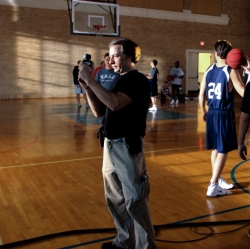
When we got to the newer gym, it was well lit by the standards of modern basketball arenas, but it would be near impossible to get decent modeling. Besides being flat overhead lighting, the color temperature was troublesome, and the windows were not rightly positioned in this case to pump light through. There were no resources available to change out the hundreds of fluorescent tubes or turn them off and re-light with some other type of lights, so I opted to leave them on, green as they were, and get my modeling via the same “Big Guns”, (K5600 Alpha 18K and 4K.) I corrected them to fluorescent by adding Rosco’s E-Colour+ #244 Full Plus Green and it worked like a charm. Our DIT, (and Northern California DCS President,) Simon Sommerfeld ran our tests through REDcine to make sure we could effectively take the green cast out in post and it seemed to work quite well. I could put the 18K all the way down at one end of the gym, bottom it with a shelf of staggered double nets, and keep it even, to follow the action all the way down to the other side of the court. A little Plus Green on my Daylight balanced Litepanels Hilios was all I needed for lights floating on the floor for fill and close-ups.
 Another practical set featuring “Mean Green” fluorescents was the real training room where they rushed Cory Weissman right after he had his massive stroke. This room had a low ceiling, impossible to keep out of the frame, and the fluorescents had somewhat unusual bases which would have been difficult to change out. Luckily they were recessed, so I was able to gel them with squares of Rosco #247 Minus Green which converted them to daylight and allowed me to light the room with my Jokers. To our eyes on the set these looked an alarming weird shade of purple, but again, after looking at tests, it worked just fine on camera.
Another practical set featuring “Mean Green” fluorescents was the real training room where they rushed Cory Weissman right after he had his massive stroke. This room had a low ceiling, impossible to keep out of the frame, and the fluorescents had somewhat unusual bases which would have been difficult to change out. Luckily they were recessed, so I was able to gel them with squares of Rosco #247 Minus Green which converted them to daylight and allowed me to light the room with my Jokers. To our eyes on the set these looked an alarming weird shade of purple, but again, after looking at tests, it worked just fine on camera.
The Lightpanels Hilio, which is fairly light weight and draws only 115 watts also came in handy for a couple of short car interior scenes. We towed the picture car with a U-haul trailer and powered two Hilios off a small inverter. The Hilios have plenty of output which allowed us to 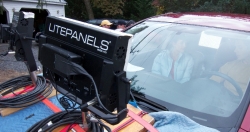 soften them with Rosco 250 Diffusion, and add Rosco #248, Half Minus Green to compensate for the green tint inherent in the windshield; (which is a challenge with many modern, energy efficient cars these days). Inside the car, a Litepanels 1×1 Bicolor running off an Anton Bauer camera battery provided plenty of exposure from the fill side, even on the very sunny day we shot. It always amazes me how close to the subject you can sneak a Lightpanels 1×1 when fighting a too bright background as in a daylight car interior. It can be right off camera, inches from the talent, but I suppose because of the many small source LEDs, it doesn’t give away your lighting, and it doesn’t torture the Actor with a hot light. All in all this was a fast, simple rig which fit the budget and shooting style of this production. I love my 1x1s and sneak them in constantly; they’re light weight, use very little power, are dimmable, color selectable, and stay cool to the touch. Litepanels also loaned me one of their new “Inca”, (denotes Incandescent), units; this one was about the size and output of a 1K Baby-Baby, but only draws a little over 100 watts, and it stays cool to the touch; gotta love these new LEDs.
soften them with Rosco 250 Diffusion, and add Rosco #248, Half Minus Green to compensate for the green tint inherent in the windshield; (which is a challenge with many modern, energy efficient cars these days). Inside the car, a Litepanels 1×1 Bicolor running off an Anton Bauer camera battery provided plenty of exposure from the fill side, even on the very sunny day we shot. It always amazes me how close to the subject you can sneak a Lightpanels 1×1 when fighting a too bright background as in a daylight car interior. It can be right off camera, inches from the talent, but I suppose because of the many small source LEDs, it doesn’t give away your lighting, and it doesn’t torture the Actor with a hot light. All in all this was a fast, simple rig which fit the budget and shooting style of this production. I love my 1x1s and sneak them in constantly; they’re light weight, use very little power, are dimmable, color selectable, and stay cool to the touch. Litepanels also loaned me one of their new “Inca”, (denotes Incandescent), units; this one was about the size and output of a 1K Baby-Baby, but only draws a little over 100 watts, and it stays cool to the touch; gotta love these new LEDs.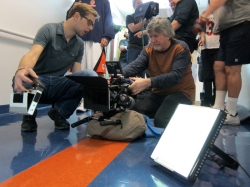
Finally, I would like to discuss camera support and power. I tend to use a JibArm a lot; mine is a Frankenstein of a contraption customized from many manufacturers’ parts including a 9 ft arm and underslung Weaver Steadman TriAxis head. For more traditional camera support, I was lucky to have my favorite fluid head, the O’Connor 2575, which is hard to beat for smooth solid dependability with a wide range of camera configurations; no matter how much paraphernalia you hang on the camera.
I was spoiled to also have a dolly and Steadicam standing by. For camera and very portable lighting needs I count on Anton Bauer, Hytron 140s for long run times when weight is not an issue, and we used their super efficient Dionic HC onboards for handheld and Steadicam.
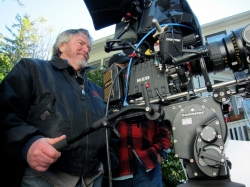
After lots of years in the Indie arena, and the huge resource of people I know through the Digital Cinema Society, I’m in a good position to line up crew and services all the way through post. I know who shares the passion to treat little movies with the same care and respect as a major feature, and who knows how to make dimes look like dollars on the screen. I know “1000 to 1” will be a movie I will be very proud to have worked on, and I couldn’t have gotten such good results without a little help from my friends. With sincere thanks, (in alphabetical order) to: Angenieux — Anton Bauer — Fujinon — Hollywood Rentals — K5600 — Litepanels — Rosco Labs — Schneider Optics — Steadicam
